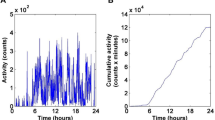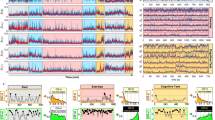Abstract
Now that the importance of rhythmicity in biological behavioural functions has been recognized, the traditional distinctions between psychology and physiology have had to be reappraised. For example, the regular alternation between mania and depression in manic-depressive psychosis suggests the possibility of underlying rhythmic phsyiological mechanisms1. Similarly, the temporal structure of social interaction has been investigated and regular patterns have been found2. Chapple3 and others4 have suggested a loose analogy between these patterns and biological rhythms. Nobody, however, has analysed the temporal structure of interaction with the perspective and statistical techniques of chronobiologists.
This is a preview of subscription content, access via your institution
Access options
Subscribe to this journal
Receive 51 print issues and online access
$199.00 per year
only $3.90 per issue
Buy this article
- Purchase on Springer Link
- Instant access to full article PDF
Prices may be subject to local taxes which are calculated during checkout
Similar content being viewed by others
References
Halberg, F., in Biological Cycles and Psychiatry (edit. by Dick, R.)(Georg, Geneva, 1968).
Chapple, E. D., Chapple, M. F., Wood, L. A., Miklowitz, A., Kline, N. S., and Saunders, J. C., AMA Arch. Gen. Psych., 3, 160 (1960).
Chapple, E. D., in Explorations in Mathematical Anthropology (edit. by Key, P.) (MIT Press, Cambridge, Massachusetts, 1970).
Jaffe, J., and Feldstein, S., Rhythms in Dialogue (Academic Press, New York, 1970).
Button, W. H., Kimberly, J. R., Lubow, B. K., and Kimberly, R. P., A Conceptual Framework for the Analysis of Work Behavior in Sheltered Workshops, Studies in Behavior and Rehabilitation No. 1 (Cornell Region II Rehabilitation Research Institute, Ithaca, New York, 1969).
Enright, J. T., J. Theoret. Biol., 8, 426 (1965).
Aschoff, J., Cold Spring Harbor Symp. Quant. Biol., 25, 11 (1960).
Henderson, A., Goldman-Eisler, F., and Skarbek, A., Lang. Speech, 8, 236 (1965).
Halberg, F., and Künkel, H., Fortschr. Med., 86, 85 (1968).
Dejours, P., Puccinelli, R., Armand, J., and Dicharry, M., Resp. Physiol., 1, 265 (1966).
Priban, I. P., J. Physiol., 166, 425 (1963).
Lubow, B. K., Kimberly, R. P., Button, W. H., and Kimberly, J. R., Human Organization, 28, 303 (1969).
Author information
Authors and Affiliations
Rights and permissions
About this article
Cite this article
KIMBERLY, R. Rhythmic Patterns in Human Interaction. Nature 228, 88–90 (1970). https://doi.org/10.1038/228088a0
Received:
Revised:
Issue Date:
DOI: https://doi.org/10.1038/228088a0
This article is cited by
-
Individual differences in vocal activity rhythm: Fourier analysis of cyclicity in amount of talk
Journal of Psycholinguistic Research (1988)
-
Rhythmic organization of social interaction and observer ratings of positive affect and involvement
Journal of Nonverbal Behavior (1987)
Comments
By submitting a comment you agree to abide by our Terms and Community Guidelines. If you find something abusive or that does not comply with our terms or guidelines please flag it as inappropriate.



